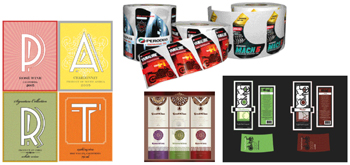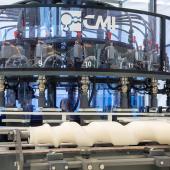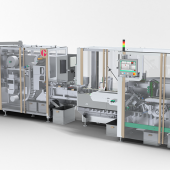Labels: the things that count
FOR WORKING What are the standards and the good manufacturing practises for self-adhesive labels for food contact? And how does one emerge unscathed from the “price war” underway in the sector, where small labeling concerns have to stand up to jumbo sized suppliers and customers? Telling questions which were answered at the 22nd Gipea Technical Convention.
The updated edition of Gipea Guideliines on pressure sensitive label for food contact, actually and factually illustrated by Maria Zemira Nociti (Studio Zetapi) and Valter Rocchelli (IrcPack), and the debated talk given by the economist Federico Visconti (SDA Bocconi) on the “price war” currently underway in the sector, were at the centre of the 22nd Assografici - Self-adhesive Label Producers Technical Convention (Milan, November 18th 2011).
A convention, as has been the case for some years, not only well attended and dense in contents, but also expression of the steps forward made by the labeling works in terms of operating as an association, with Gipea evermore able to voice problems, analyses, proposals and – neither banal nor to be taken for granted – to stimulate exchanges of information and ideas between operators. As always at the encounter the most active of suppliers offered a series of product and service presentation.

Grow big while you are still little - Let’s start from the end, or that is the talk given by Federico Visconti, which stimulated lively participation among the public. The University Professor tackled the great themes which the sector entrepreneurs are faced with, starting from the subject of the day, the “price war”, or that is the liaison dangereuse between the label supplier, often small in size, and the large/huge suppliers and customers:«What can be said of a market where just a few multinational provide a raw material that eats away 30 to 40% of the labeling works’ profits?».
The economist spoke of the changes that the entrepreneurs have to implement without further delay in order not to risk getting stranded inevitably marginalised. Starting from the typical difficulties and recurrent situations, he highlighted three assumptions to be analysed to find the most concrete of responses to the urgent problems of today. These are also expounded in the book which Visconti has just published along with his colleague Guido Corbetta for the publisher Egea:
- the entrepreneurs are the prime drivers in the change needed to face the current difficulties but first and foremost they have to themselves change;
- today there is no longer space for “one man bands” or the family approach: a concern, even if it is small, has to have a managerial organization;
- the taboo of size has to be tackled: innovating, conquering international markets, grouping together with competitors, opening up capital…
These are principles that have been reiterated time over in many locations and that all the same the “small” entrepreneur often feels uneasy with in that the same has not as yet been capable of turning the said principles into projects and actions that comply with the structure and turnover of the selfsame company.
Visconti suggests various ways of avoiding this dead end, provided one is prepared to change mentality. A managerial structure, for example, can represent the result of an inner process of clarification and delegation that, by definition, starts out with the reviewing of tasks and areas of competency and ends the assignment of responsibility; perhaps going by way of the professional growth of a son or daughter, «who often proves capable and committed, as well as a bringer of new and productive viewpoints».
In the same vein, the indispensable growth in size of the small and medium sized concern, that has to increase its critical mass in order to have a greater impact on the market, certainly does not come about through simply “buying a new machine”, but implies growth along external lines. And this does not necessarily occur by way of a buy-up (that often implies the exit of the purchased company’s entrepreneur), but can take on the form of a network of companies, of alliances with complementary concerns, or joint ventures with a competitor on a given market or strategic application and so on and so forth. Enlightening examples of the former are not hard to find: it is worth taking a peek at Visconti’s book, aboveall in the chapters headed “I nodi da sciogliere” and “Le strade da percorrere” (“The problems that need to be solved” and “The ways to be taken”).
The new Guidelines - The updating of the Gipea Guidelines was promoted and carried out by experts “borrowed” from the companies, with the objective of considering the specificity and development of self-adhesive materials and the evolution of the main framework of standards. The new document can be found online, with links to the related standards, inasmuch as liable to constant, just-in-time updates.
Compared to the preceding edition, new space has ben dedicated to the cleaning of machines in the changeover from a non food job to a job for the food sector (to be performed when there are no dedicated print lines, as indicated by the Nas, the Carabinieri’s anti food adulteration squad) and the updates on the anchorage and migration of inks; on models and procedures covering the traceability of materials and objects for food contact, including reprimand procedures and withdrawal of goods; to the good manufacturing practises and in particular to the CAST project. With a full array of models, complimentary guidelines and main standards.
The presentation of the work was followed by a sort of lesson summing up the same, centred on inks for food contact, that as is known, constitute a particularly delicate aspect in the printing of labels and packaging.
This was carried out by Valter Rocchelli, in a talk titled “Evaluation of the risks of sensual and toxic damage of materials destined for food contact” that summed up the contents of the main standards that must be known and respected. His talk, with a concrete and practical slant, was full of advice and details and can be found, along with the other talks of the day in an easily consultable version, on the Gipea website.

















